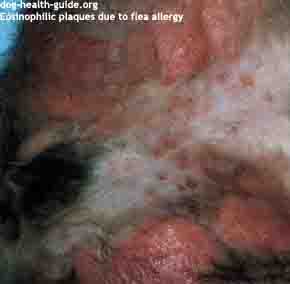Overview
Pimples from fleas are caused by an allergic reaction to the saliva passed from the flea to your dog (called flea bite antigen). Flea bite hypersensitivity tends to appear during the summer and fall. Dogs easily pick up fleas after contact eggs that fall off infected animals. It is the most common skin disease in dogs. Pets that suffer from fleas related skin problems get worse with each incident.
Pimples Due To Dog Flea Allergy

Source: Washington State University
Even if you believe that your dog doesn't have fleas, don't rule it out until you thoroughly check the coat with a flea comb. Fleas are notorious at being able to hide from view and could have been brought into a home by an unsuspecting human. One easy way to check is to comb your dog while your pet is standing on a damp paper towel. If you see what looks like coffee grounds on the paper that dissolves into red streaks, then your dog is suffering from canine flea bite hypersensitivity.
Another technique is to image an line separating the front and back of the dog. If the dog itches more in the back half, then fleas could be the cause.
If you don't find fleas, they cannot be ruled out, since dogs that over groom might remove signs of fleas, even though the were the cause prior to removal.
Symptoms
Symptoms/Affected Sites: The most common symptoms is some type of skin reaction such as the formation of pimples. Itch caused by the reaction results in scratching and itching (particularly on the back half of the dog), leading to secondary problems such as irritation, redness and infection. A typical reaction is licking of the back half of the body.
Most commonly affected areas of the dog's body are the tail, nose, thighs, groin, belly and anus. In males there may be crusted papules in the umbilical fold.
Chihuahua with Fleas and Skin Infection
Diagnosis
Skin testing such as scraping for fleas, or tests for dog flea allergy (ELISA, RAST) and identification of fleas on the dog. The disease will need to be differentiated from other causes of dog skin irritation and pimples such as food, environmental allergies (atopy), sarcoptic mange, cheyletioellosis and skin diseases that can cause itch.
The diagnosis can also be confirmed based on the positive response to treatment.
Treatment
There is no cure for flea bit hypersensitivity, meaning that each time your dog is exposed, he or she will have an allergic reaction. The best approach is to remove the cause of the allergic reaction, which are the fleas themselves.
Dogs with fleas need both the fleas to be removed and then the use of a preventative to keep them away. Today, products in the form of a spray, powder or topical spot on will kill fleas on contact and act as an insect growth regulator (IGR), which interferes with the flea reproduction cycle. Popular brands include Frontline®, Advantage®, Capstar® and Revolution®. Other popular products include a fipronl spray such as Frontline Spray Treatment.
You should also treat the area where the dog lives with, methoprene (Altosid), fenoxycarb, or pyriproxifen.
Spot on treatments as mentioned above have replaced the use of a flea dip such as Adams. Dips will kill fleas, but can have side effects such as dry or irritated skin.
Corticosteroids can be used over a short period of time to help with any dog skin itch. Antihistamines can help relieve symptoms such as itch.
References:
Flea Allergy Dermatitis
Peter F. Ihrke, VMD, ACVD
Professor of Dermatology
School of Veterinary Medicine
University of California
Researched by: Jeff Grill
